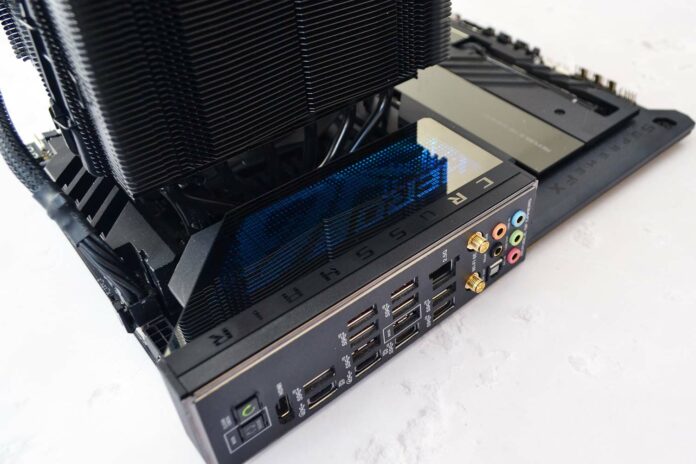AMD’s Ryzen 7000 Series launch heralds great opportunity for motherboard partners to release high-performance X670E and X670 solutions. ‘E’ is the way to go for full feature goodness, and presented in a two-chip arrangement, AMD integrates a heck of a lot of useful connectivity. Motherboard guys need to think carefully about how to lay out features and what to add to differentiate theirs from the competition.
The Asus Crosshair Hero of any AMD generation is usually a good benchmark of how to do things right, and we have the £650 X670E model in for review today. Let’s get cracking on what could be the ideal partner for benchmark-bustin’ Ryzen 7950X.
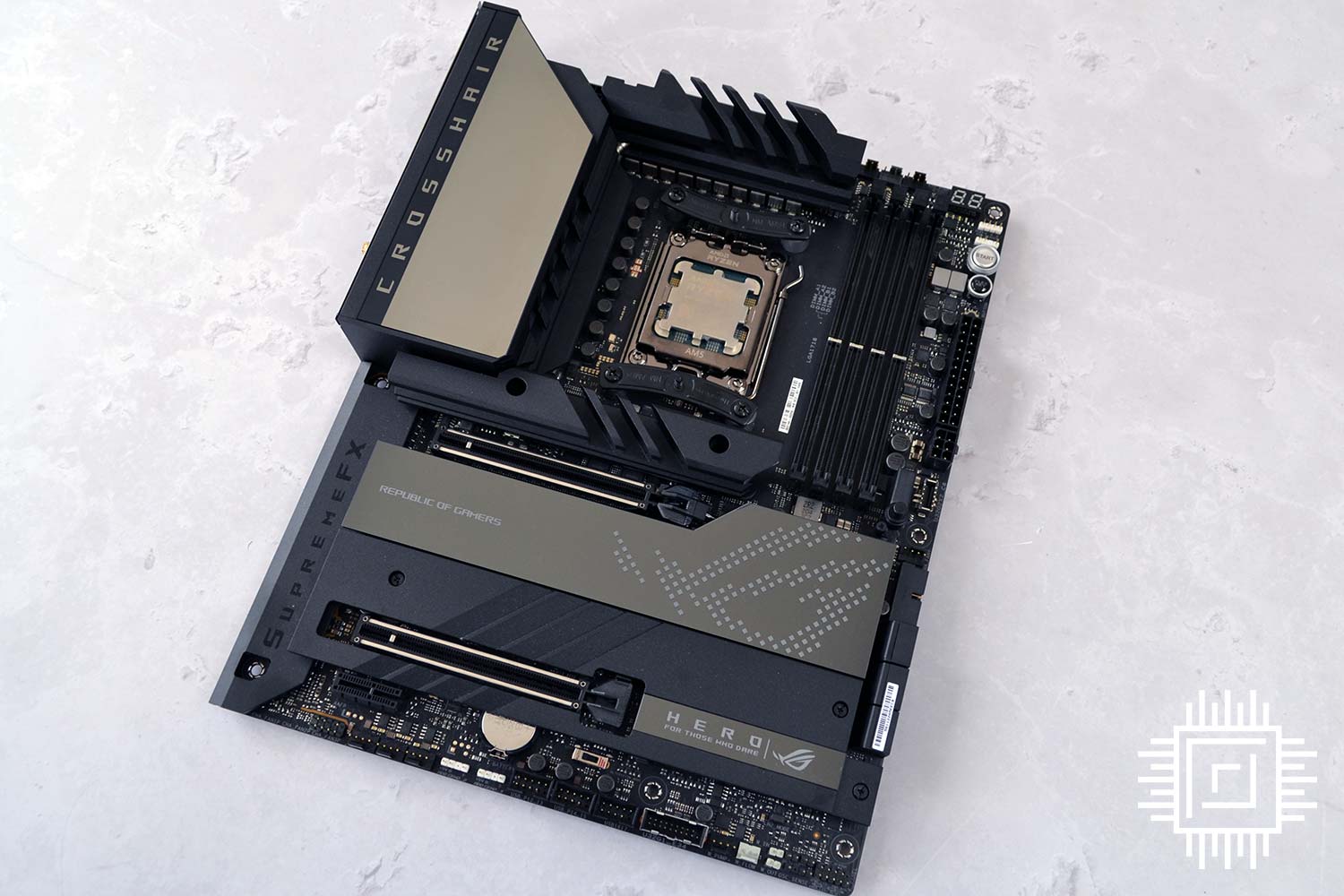

Asus ROG Crosshair X670E Hero
£650
Pros
- Looks great
- Good layout
- User friendly M.2 and PCIe
- Best-in-class BIOS
- USB 4
Cons
- No Thunderbolt 4
- 10GbE would be nice
Club386 may earn an affiliate commission when you purchase products through links on our site.
How we test and review products.
Asus follows a recent trend of covering the board with heavy-duty heatsinks. Unlike many competitors, Crosshair X670E Hero sticks to a standard ATX form factor, though it doesn’t feel cramped as a result, which speaks to good layout decisions.
There’s merit in leaving a large gap between the LGA1718 AM5 socket and primary PCIe 5.0 x16 slot. Moving it down, compared to previous generations, enables an oversized M.2 heatsink for the uppermost PCIe 5.0 x4 slot and also ensures an adequate gap between graphics card and CPU cooling.
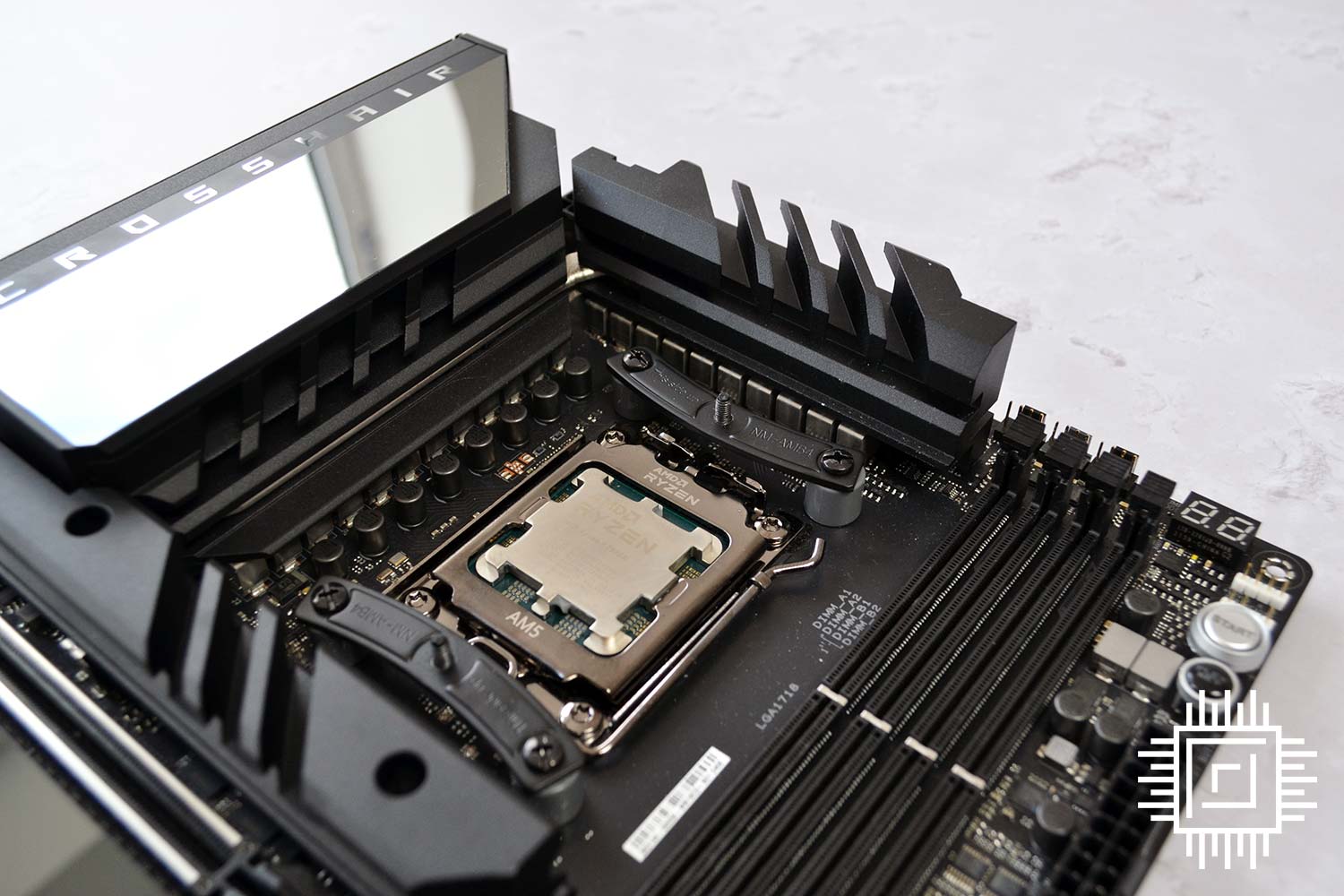
Make no mistake, every X670E board is overengineered from a power-delivery standpoint. Asus is no exception as Hero adopts an 18-phase teamed supply for the CPU plus another two for SoC and memory. Each stage is rated at 110A, meaning there’s around 2,000A on tap going full grunt. Good luck in pulling more than 400A without blowing AMD’s nascent speed monsters up.
The two heatsinks are impressively thick and connect to each other via a large, flat heatpipe. Like the recently reviewed ASRock X670E Taichi, installation and robustness are top notch – you can also lift the board by holding on to the uppermost cooling. Asus has thought about design (and fingers!), too, as the exposed heatsink has sharp edges on the outside but is smoother in construction on the inside. Absolutely nothing flexes on this board, from the twin eight-pin CPU connectors on one edge to cooling at the bottom. Impressive considering X670E Hero has no rear metal brace plate.
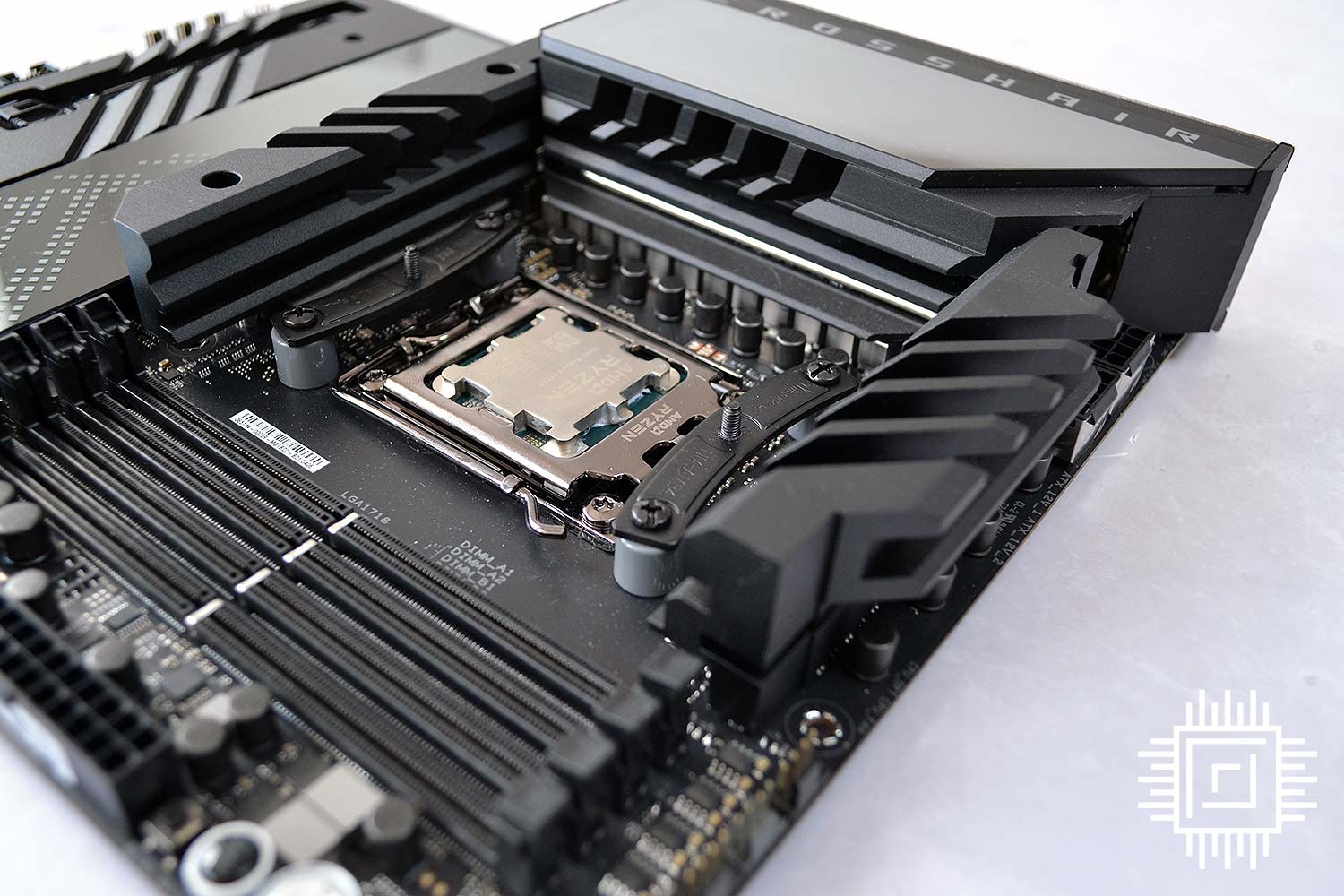
Choosing not to opt for the extra width available on E-ATX doesn’t obviously harm Hero; adding a cooler and memory is as easy as on the wider aforementioned Taichi.
There’s no fan in the gap between CPU-surrounding heatsinks nor the full-coverage I/O ensemble; Asus clearly has confidence in a passive design. Speaking of I/O, the mirror-like finish on top is attractive at rest but springs into RGB action once the board is powered up. Known as Polymo lighting, it’s a feature carried over from the Z690 model and looks fantastic. The large display is crying out for user customisation, but alas, the only option is the adjust the colours for the cycling ROG and Hero pre-configured animation.
It won’t surprise you to learn that Z690 Hero and X670E share many design traits – power phases are slightly different, but that’s about all – and we see that as a positive thing. For the time being, there is no bespoke ‘Eva‘ edition, if you were wondering.
Stepping down the product, Asus changes implementation up when compared to Z690. That board’s bottommost PCIe x16 slot is given the boot and replaced by a single PCIe x1 instead. This means there are only two PCIe 5.0 x16 slots, with the second further down, leaving more room for heatsinks and inevitable quad-slot cards from the next generation of high-performance graphics cards.
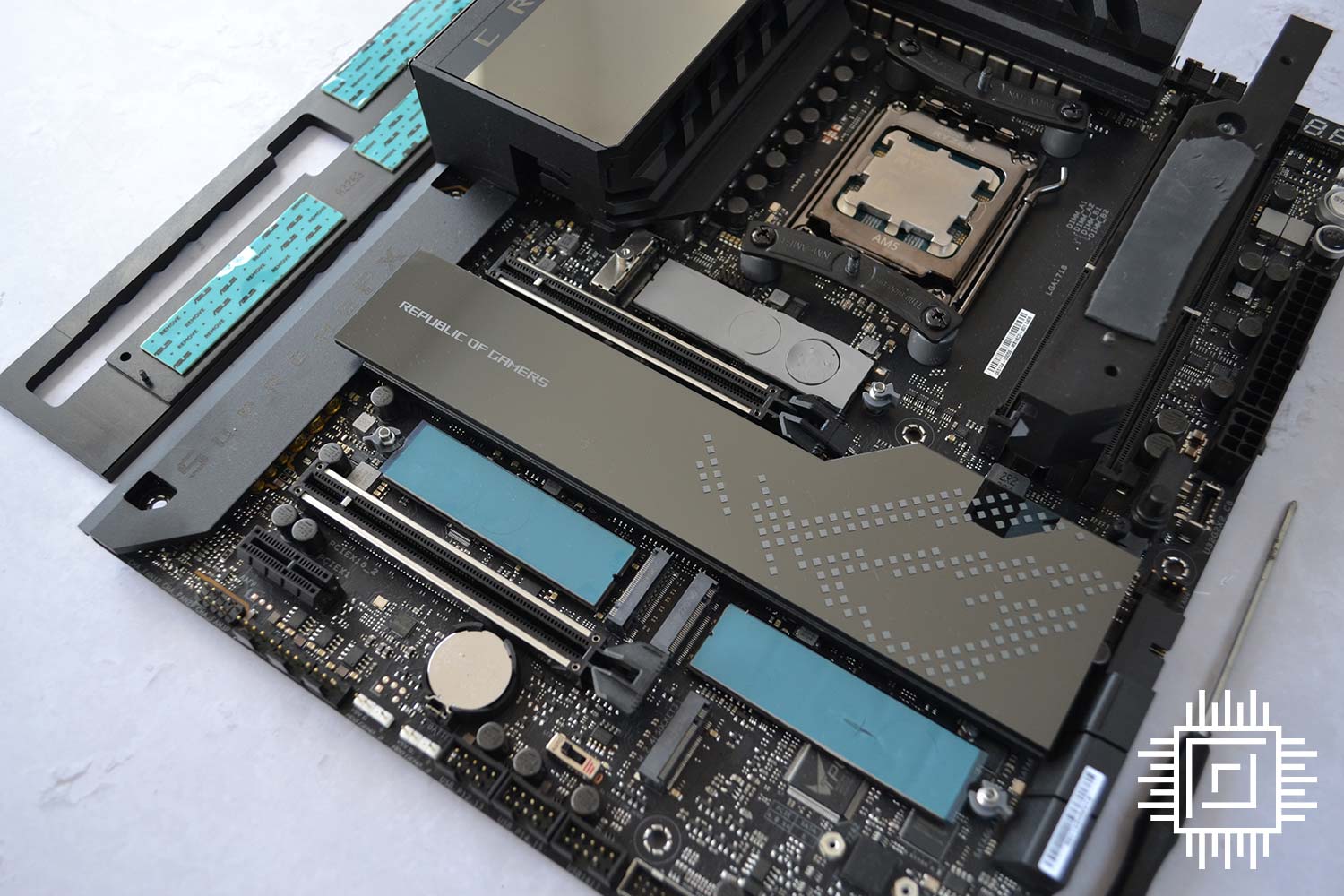
Three features stand out on Asus boards, and they combine to leave a premium feel others struggle to match. The first is thermal strips underneath three of the four M.2 slots. The second is the quick-release button for the primary PCIe x16 slot. Located just above the six SATA ports and using a simple wiring system, it makes getting large graphics cards out a cinch; no more pushing flat-headed screwdrivers to disengage. The third is also simplicity itself. Notice the grey plastic appendages near each M.2 slot? They turn to lock in the M.2 drive(s), so no more ferreting around for those tiny screws that go missing with consummate ease.
Most motherboard guys choose to have the twin X670E chips located diagonally across and down from one another. There’s no room for it with the orientation of the slim ROG Asus heatsink. Instead, they’re located horizontally. Not that it matters, but kind of geeky to know.
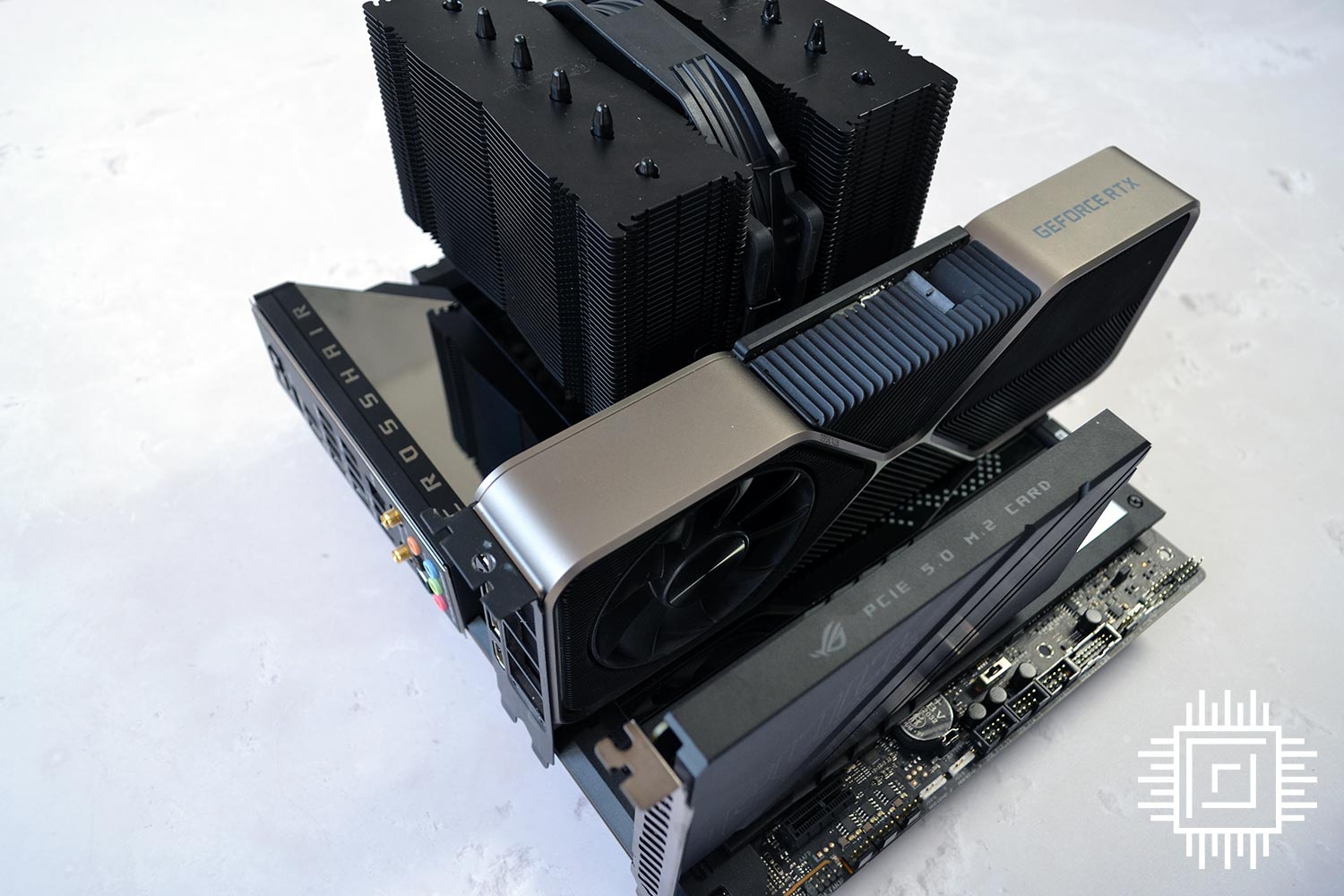
Thinking about how you should attach M.2 drives, the top and one directly below it connect to the CPU via PCIe 5.0 x4 interfaces. The remaining two, on the bottom right, run off the X670E chipset; Asus doesn’t divulge how they are routed.
Four M.2 slots evidently aren’t enough to sate the Asus storage desire. X670E Hero’s package also comes with an M.2 card which adds another PCIe 5.0 x4 by taking up room on the bottom slot usually reserved for graphics. This is a wise move as most enthusiasts tend to rock only a single graphics card. All told, then, there are three PCIe 5.0 x4 and two PCIe 4.0 x4 slots available. The pictured Nvidia GeForce RTX 3080 Founders Edition isn’t included, sorry.
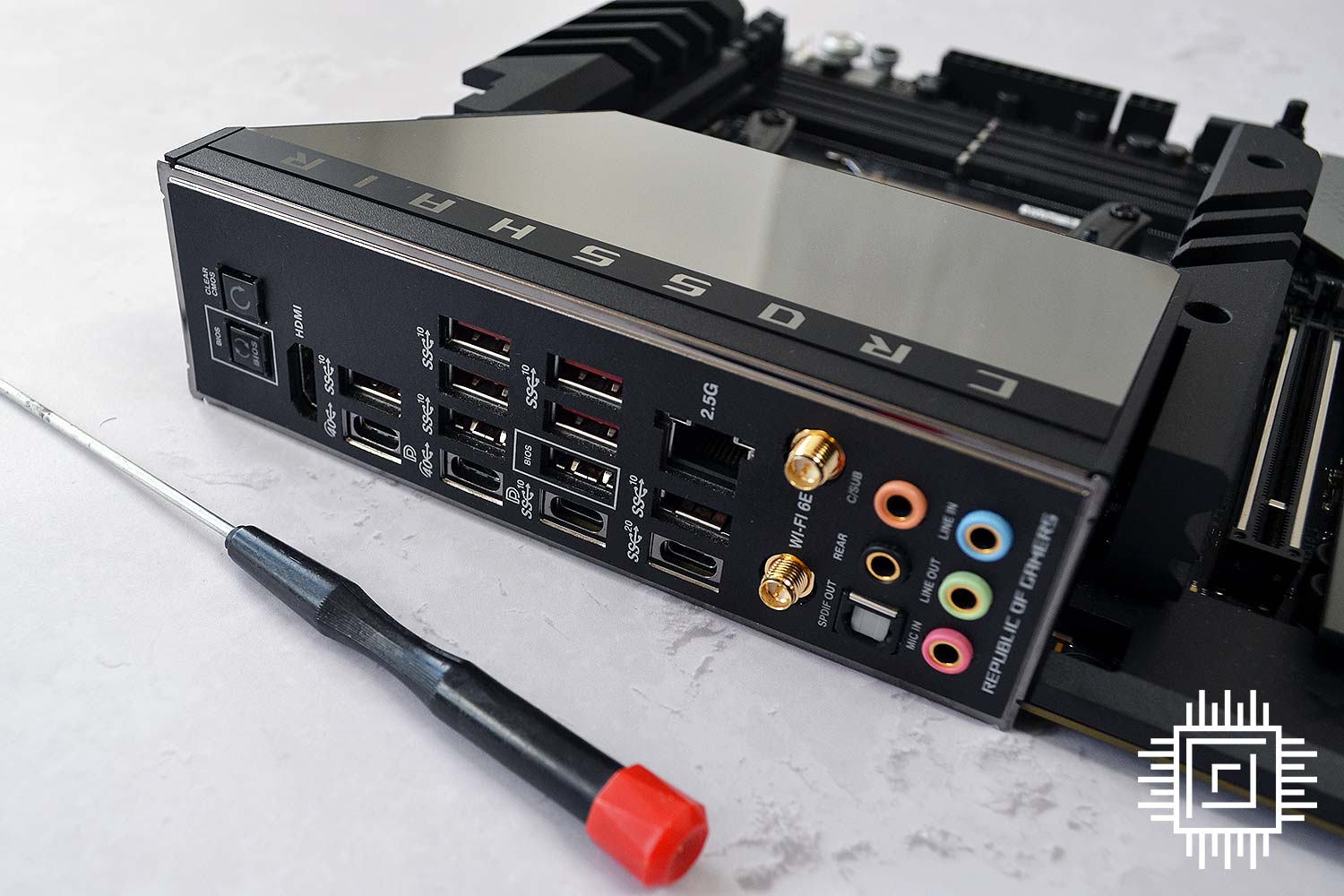
Shifting gears and going around back, 12 USB ports are most welcome, of which two are USB 4 Type-C. Asus achieves this by using an Intel Maple Ridge JHL8540 Thunderbolt 4 controller, much like ASRock Taichi and Asus Z690, yet do appreciate Crosshair X670E Hero doesn’t have Thunderbolt support – the ports are USB 4 only and support up to 60W charging. Top marks to Asus for ensuring other USB on the rear are 10Gbps, too.
We continue to believe 2.5GbE LAN is stingy on a £600+ board – mobo guys, please transition to 10GbE quickly – but there’s good news on the rear by way of a 20Gbps USB Type-C port, as well as a front-panel connector of the same speed on the PCB itself. Last but not least, audio is also premium, marrying the ALC 4082 codec with an ESS9128 DAC.
Asus has mostly sensible choices that combine to offer a seamless installation and user experience.
Specification
| Asus ROG Crosshair X670E Hero | ASRock X670E Taichi | |
|---|---|---|
| Price | £650 | £630 |
| CPU power delivery | 18-phase 110A | 24-phase 105A |
| Native M.2 | 4 (2 PCIe 5.0, 2 PCIe 4.0) | 4 (1 PCIe 5.0, 3 PCIe 4.0) |
| SATA | 6 | 8 |
| USB 20Gbps | 2 (I/O, board) | 1 (board) |
| Total rear USB | 12 | 10 |
| LAN | 1 2.5G | 1 2.5G |
| Physical PCIe | 2 x16 PCIe 5.0 1 x1 PCIe 4.0 | 2 x16 PCIe 5.0 |
| Audio | ALC 4082 / ESS9128 DAC | ALC 4082 / ESS9128 DAC |
| RGB | Yes, one section | Yes, two sections |
| USB 4 | Yes, two ports | Yes, two ports |
| Thunderbolt 4 | No | Yes, same ports as above |
| Wi-Fi | Intel Wi-Fi 6E AX210 | Killer Wi-Fi 6E 802.11ax |
| Fan headers | 7 | 8 |
| Video output | HDMI 2.1 | HDMI 2.1 |
| Form factor | ATX | eATX |
Comparing two £600+ boards, there’s not a lot in it. Asus has more and better M.2 support and the better-looking RGB implementation, ASRock runs with even more ludicrous power delivery and Thunderbolt 4. You pays your money and makes your choice.
Firmware
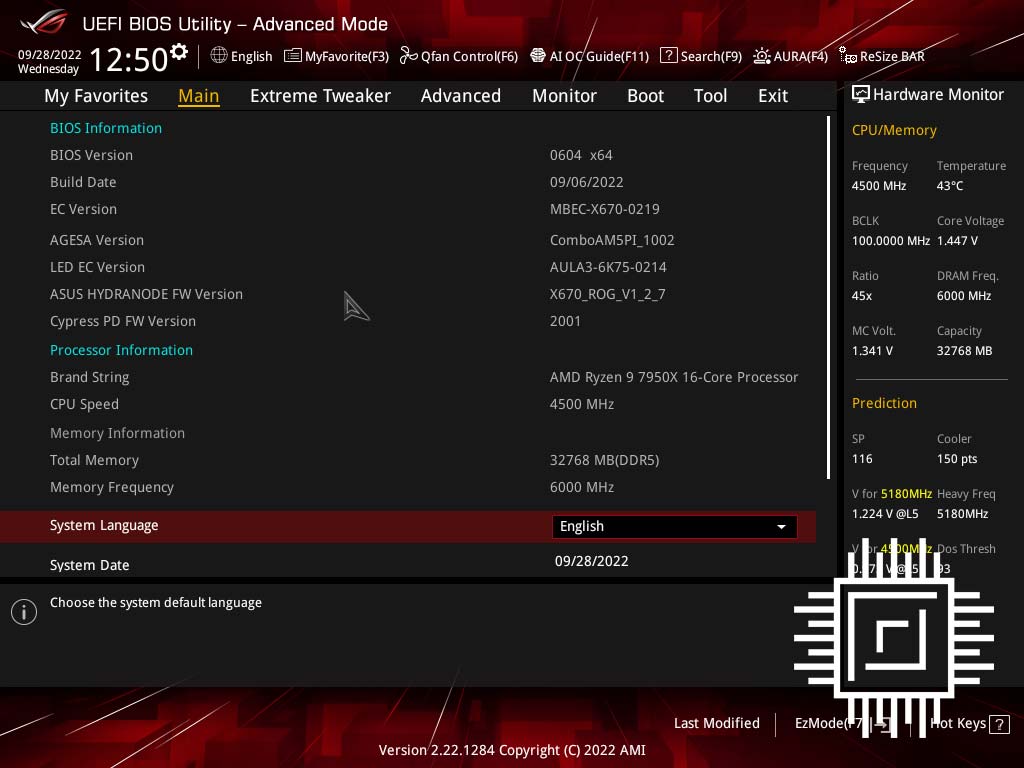
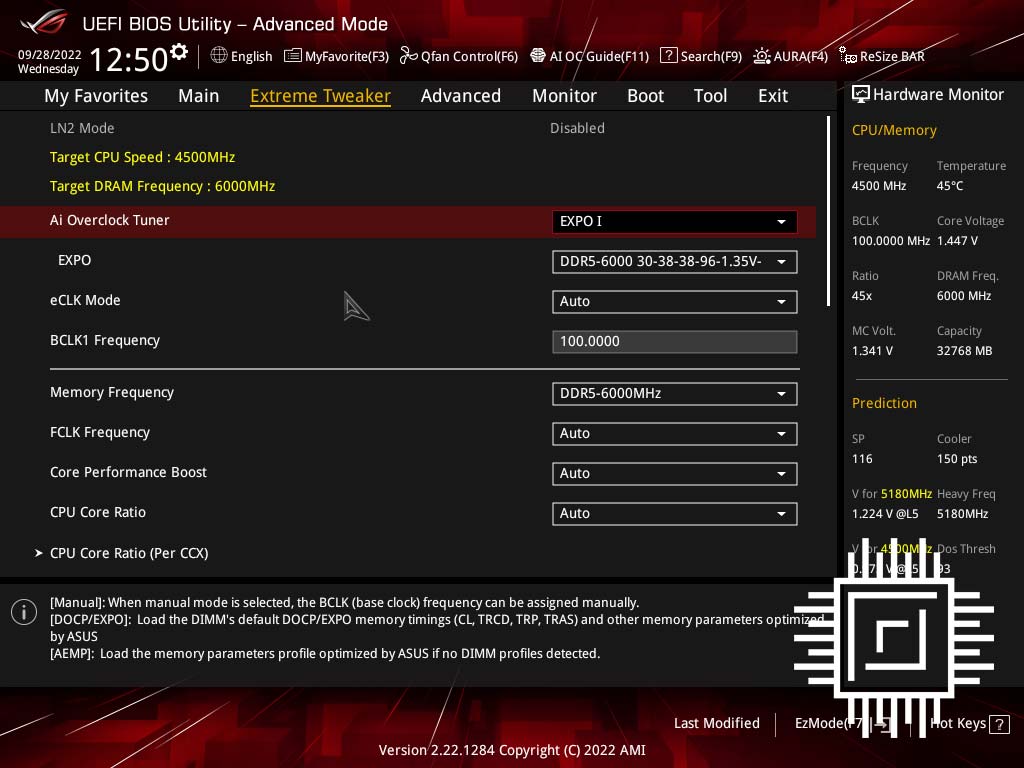
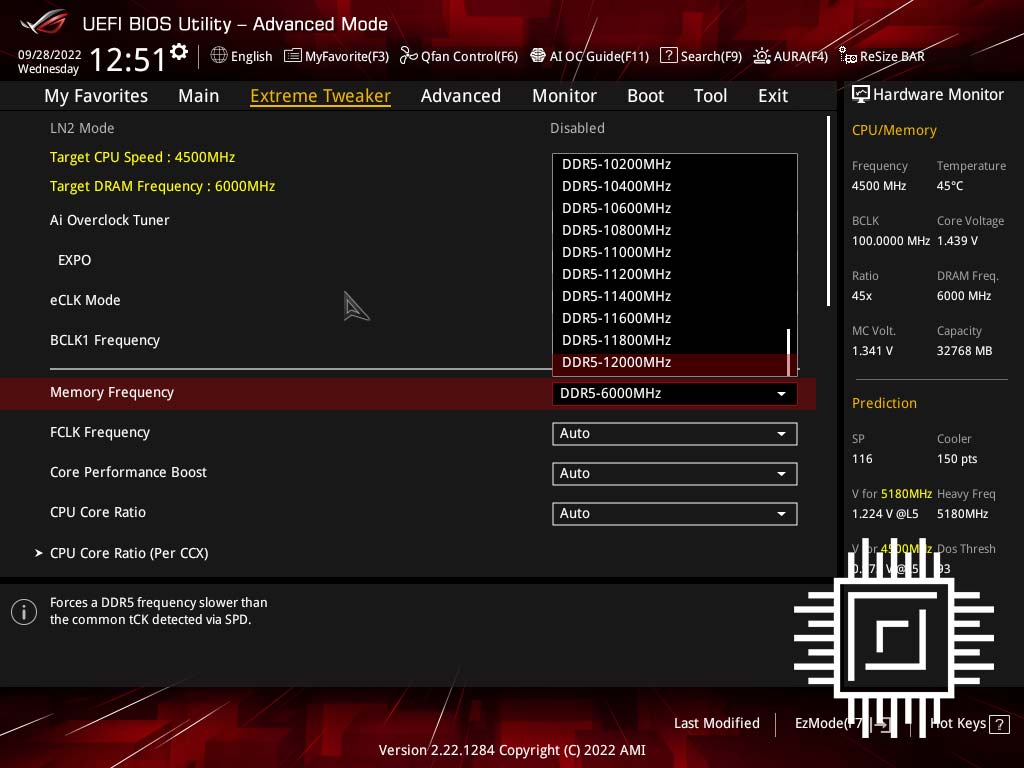
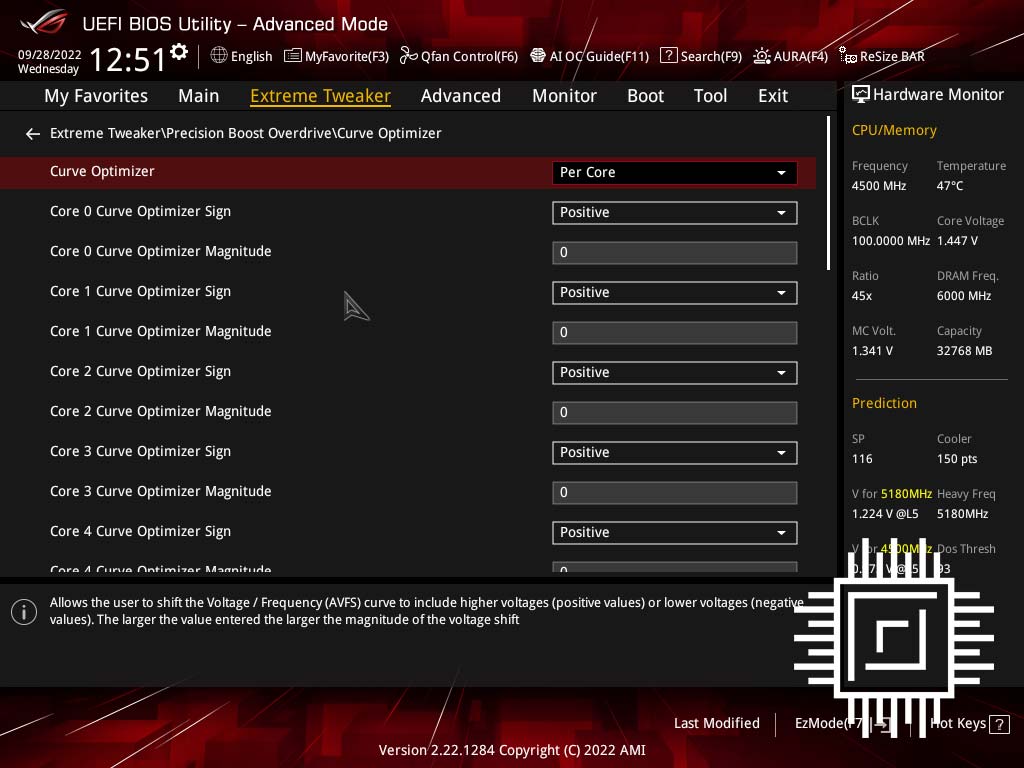
There’s normally some slight on how a company implements the BIOS. Not so for Asus, who has the best firmware in the industry. Smooth, responsive and easy to understand, this is the gold standard.
Performance
The two AMD platforms used a Ryzen 9 7950X whilst Intel Z690 leverages Core i9-12900K. Numbers are carried out using a 32GB (2x16GB) G.Skill Trident Z5 Neo memory kit operating at 6,000MT/s and CL30. Rounding it off, there’s Nvidia GeForce RTX 3080 FE graphics and Noctua NH-D15 cooling.


With all three platforms running at DDR5-6000, memory copy bandwidth is somewhat down on AMD.



Yet there’s nothing wrong with multi-core performance from the barbaric Ryzen 9 7950X.

AMD is no longer the slower cousin for PCIe 4.0 x4 drives. A Seagate FireCuda 530 runs at a near-identical speeds on all three boards.


Hero wins some, loses some, yet the difference between first and third is negligible.





Expect top-notch gaming performance from any of these premium platforms.

Stock power consumption, as expected, is also markedly similar. There’s always the option to lower CPU wattage; you might be surprised how little is lost in performance.
Overclocking
| Asus ROG Crosshair X670E Hero | ASRock X670E Taichi | |
|---|---|---|
| Maximum all-core CPU speed at 1.292V | 5,350MHz | 5,350MHz |
| Maximum memory speed at 1.4V | 6,400MT/s | 6,400MT/s |
| Cinebench R23 multi-core | 39,008 score | 39,114 score |
| Gears Tactics – FHD | 200/163FPS | 201/165FPS |
The days of overclocking are limited. Even a dyed-in-the-wool enthusiast will struggle to push performance some way above stock numbers. If you decide to do so, the Asus firmware is excellent at exposing all the right options for maximising an overclock.
Run at out-the-box speeds, HWInfo reports a maximum VRM temperature of 55°C after a 15-minute all-core benchmark thrashing. That’s perfectly acceptable for long-term operation.
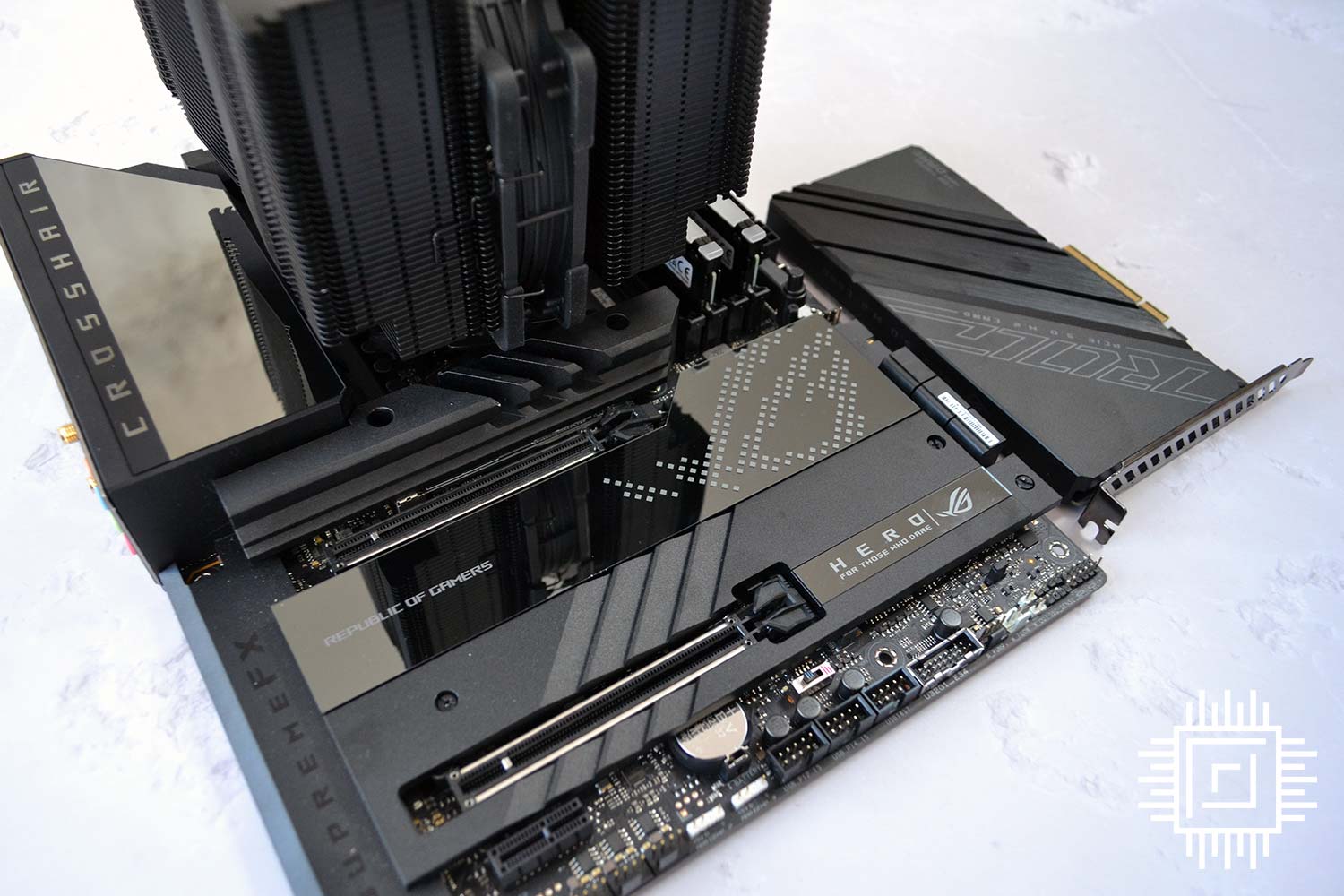
Conclusion
The Asus ROG Crosshair Hero family has been a go-to choice for many an enthusiast needing a premium motherboard for AMD CPUs. Riding on the latest high-performance X670E chipset, today’s Crosshair does heck of a lot of things right.
It’s an attractive beast and backs up looks with a rock-solid specification. Key callouts are five M.2 slots, USB 4, beautiful lighting, and a comprehensive I/O selection. BIOS continues to be class leading, too.
In an ideal world we’d like to see Thunderbolt 4, 10GbE, and an OLED screen implemented. That board does exist, save for Thunderbolt, and goes by the name of Crosshair Extreme, but expect to pay over £900 for the privilege.
Asus continues to keep the motherboard bar high with ROG Crosshair X670E Hero. If your heart is set on Ryzen 9 7950X, and why not, Hero is a fine, dependable home for it to strut high-performance credentials.
Verdict: An impressive AMD X670E board mixing thoughtful features with great aesthetics.


